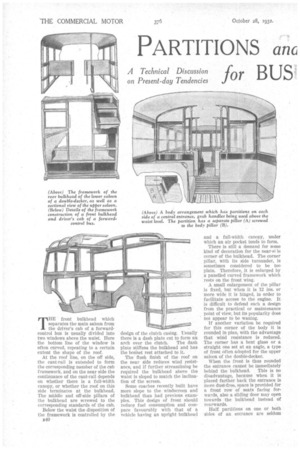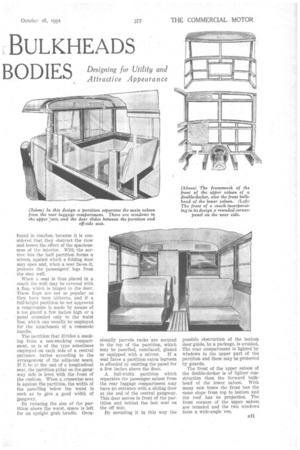PARTITIONS an
Page 66

Page 67

If you've noticed an error in this article please click here to report it so we can fix it.
BULKHEADS
for BUS
BODIES
THE front bulkhead which separates the main saloon from the driver's eab of a forwardcontrol bus is usually divided into two windows above the waist. Here the bottom line of the window is often curved, repeating to a certain extent the shape of the roof.
At the roof line, on the off side, the cant-rail is extended to form the corresponding member of the cab framework, and on the near side the continuance of the cant-rail depends on whether there is a full-width canopy, or whether the roof on this side terminates at the bulkhead. The middle and off-side pillars of the bulkhead are screwed to the corresponding standards of the cab.
Below the waist the disposition of the framework is controlled by the 1340 design of the clutch casing. 'Usually there is a dash plate cut to form an arch over the clutch. The dash plate stiffens the bulkhead and has the bonnet rest attached to it.
The flush finish of the roof on the near side reduces wind resistance, and if further streamlining be required the bulkhead above the waist is sloped to match the inclination of the screen.
Some coaches recently built have more slope to the windscreen and bulkhead than had previous examples. This design of front should reduce fuel consumption and compare favourably with that of a vehicle having an upright bulkhead and a full-width canopy, under which an air pocket tends to form.
There is still a demand for some kind of decoration for the near-si le corner of the bulkhead. The corner pillar, with its side turnunder, is sometimes considered to be too plain. Therefore, it is enlarged by a panelled curved framework which rests on the front wing.
A small enlargement of the pillar is fixed, but when it is 12 ins, or more wide it is hinged, in order to facilitate access to the engine. It is difficult to defend such a design from the practical or maintenance point of view, but its popularity does not appear to be waning.
If another variation he required for this corner of the body it is rounded in plan, with the advantage that wind resistance is reduced. The corner has a bent glass or a straight one set at an angle, a type of front often adopted for the upper saloon of the double-decker.
When the front is thus rounded the entrance cannot be immediately behind the bulkhead. This is no disadvantage, because when it is placed farther back the entrance is more dust-free, space is provided for a front row of seats facing forwards, also a sliding door may open towards the bulkhead instead of rearwards.
Half partitions on one or both sides of an entrance are seldom found in coaches, because it is considered that they obstruct the view and lessen the effect of the spaciousness of the interior. With the service bus the half partition forms a screen, against which a folding door may open and, when a seat faces it, protects the passengers' legs from the step well.
When a seat is thus placed in a coach the well may be covered with a flap, which is hinged to the door. These flaps are not so popular as they have been hitherto, and if a full-height partition be not approved a compromise is made by means of a toe guard a few inches high or a. panel extended only to the waist line, which can usually be employed for the attachment of a commode handle.
The partition that divides a smoking from a non-smoking compartment, or is of the type sometimes employed on each side of a central entrance, varies according to the arrangement of the adjacent seats. If it be at the end of a longitudinal seat, the partition pillar on the gang*ay side is level with the front of the cushion. When a crosswise seat is against the partition, the width of the panelling below the waist is such as to give a good width of gangway.
By reducing the size of the partition above the waist, space is left for an upright grab handle. Occa
sionally parcels racks are secured to the top of the partition, which may be panelled, ventilated, glazed
or equipped with a mirror. If a seat faces a partition extra legroom is afforded by omitting the panel for a few inches above the floor.
A full-width partition which separates the passenger saloon from the rear luggage compartment may have an entrance with a sliding door at the end of the central gangway. This door moves in front of the partition and behind the last seat on the off side.
By mounting it in this way the possible obstruction of the bottom door guide, by a package, is avoided. The rear compartment is lighted by windows in the upper part of the partition and these may be protected by guards.
The front of the upper saloon of the double-decker is of lighter construction than the forward bulkhead of the lower saloon. With many new buses the front has the same slope from top to bottom and the roof has no projection. The front corners of the upper saloon are rounded and the two windows form a wide-angle vee.






































































































